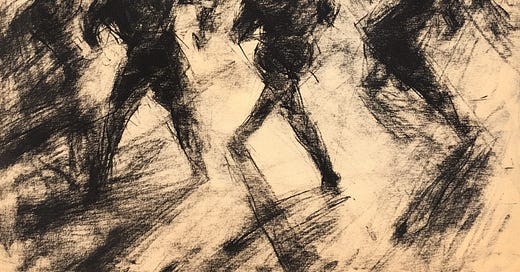Running is Having a Roaring ’20s Moment
World records tumble across 1 week. Plus LIVE with Mario Fraioli on Substack: Tomorrow, 1:30 PM PT.
Welcome back to Footnotes. Here are some stories that caught my eye this week.
A note before we jump in: tomorrow at 1:30 p.m. PT, Mario Fraioli are trying something new—a live Substack conversation!
It’s a rolling, unscripted chat and LIVE so you can jump in. Bring your questions, hot takes, and popcorn to the Substack app or website.
We’re not sure how it will go, but we’re excited to chat about trends in running, happenings on the pro circuit, and writing about running. Maybe see you there tomorrow!
Now onto the newsletter.
1. Rapid-fire World Records
It’s been a week that shook the boards of indoor track to their foundations. On February 8, Grant Fisher edged away from fellow American Cole Hocker at the Millrose Games to set the world record in the 3000m indoors. An hour later, Yared Nuguse broke the world record in the indoor 1500. Then five days after that, Jakob Ingebrigtsen ran 3:45.14 to break Nuguse’s new record.
The next weekend on Friday, February 14, six days after his 3000m record, Grant Fisher demolished the 5,000 meter indoor record, chopping off five seconds (five seconds!) from the record set over two decades ago by Kenenisa Bekele.

Yes, the technological landscape has changed, but Fisher’s performances are astounding. In the 5K, Fisher ran solo over the second half after pacer Henry McLuckie stepped off, managing to clock the next 13 laps under 31 seconds, averaging 4:05 pace for 3.1 miles.
As someone who came of age in the mid-2000s, when east African talents like Bekele seemed impossible to match, an American systematically dismantling those records is stunning to behold.
Then yesterday, at the eDreams Mitja Marató in Barcelona, Jacob Kiplimo ran 56:41, shattering the half-marathon record by 49 seconds, the largest single improvement on the men’s half record in history. To put the run in perspective, the Ugandan’s 5K to 15K split of 26:33 is the same as Grant Fisher’s best mark on the track. His pace was 4:19.5 for 13.1 miles. So fast, it’s silly.
Such is the sheer depth of talent in running right now that old records crumble by the day. Like a positive contagion effect, each high performance cascades virally through the professional ranks.
It really does feel like the Roaring 1920s all over again—kleptocrats in power, ominous vibes pulsing through the world’s political economy, and some damn good track and field performances.
Recaps worth reading:
Taylor Dutch for Runner’s World on Fisher’s 5K splits and race
Jonathan Gault for Letsrun breaks down Ingebrigtsen’s 1500 WR
Rachel Bachman for The Wall Street Journal, “The Indoor Mile World Record Stood for Years. Then It Fell Twice in Five Days”
Chris Chavez for Citius, “By the Numbers: Kiplimo Shatters Half Marathon Record”
2. How to Pick New Running Shoes (NY Mag)
This New York Magazine piece gives a comprehensive survey of some of the best shoes on the market right now. And it provides fitting guidance from scholars of kinesiology: just go on comfort.
It’s a striking departure from the paradigm of shoe selection from a couple decades ago, which emphasized finding a shoe that matched your individualized gait and biometrical pattern. Now the experts defer to a runner’s subjective experience. “Everybody’s got their own preferred movement pathway, and their footwear should support that,” noted Ben Langley, lecturer of biomechanics at Edge Hill University in the UK.
I can’t help but draw comparisons with other domains of knowledge—politics, healthcare, science—wherein expert advice has been replaced by individual preference, the vibes of the masses, and ‘common sense’. Pedes populi, pedes Dei, I suppose.
3. “In Praise of the Pedestrian” (Untapped)
I enjoyed this profile from Phillip Cox on the artist and his practice of using walking as a medium to uncover hidden narratives within urban landscapes. Trained as a sculptor, Wolfe shifted his focus to walking in 2018, journeying through various American locales to delve into the interplay between human-made infrastructure and lived experience.
While the article centers on a walk in Manhattan, Wolfe often traverses areas overlooked or deemed uninteresting, such as industrial zones and suburban neighborhoods. Wolfe documents landscapes many runners and walkers intuitively sense but rarely articulate revealing accumulated stories embedded in everyday spaces.
Find Wolfe’s work in his monthly newsletter, Pedestrian:
4. Urban Greenways Grow (Time)
New city greenways, like Detroit's Joe Louis Greenway, are transforming urban landscapes by converting industrial areas and abandoned rail lines into networks of walking and biking paths. A concise article from Time shows how dedicated space for walking, cycling, and running not only supports healthier communities but spurs local economies:
”Adjacency to the [Lafitte Greenway in New Orleans] was a deciding factor for Jeff Hinson and Breanna Kostyk, when they opened Flour Moon Bagels two years ago . . . ‘We feel like the greenway is the front porch of the bagel shop. From day one, we’ve had so many guests stop in, biking or walking.’”
Many greenways need improvement though. Most lack bathrooms and benches to make the pathways more accessible. Moreover, new greenways could become highway systems for cyclists, but lack protected bike lanes to connect with city streets.
Tweets of the week
That’s it for this week. Thanks for reading.










Thanks for the mention, Sam!
It's been quite a week! I'm looking forward to the recap of your chat with Mario (it will be the wee hours here in Austria).
Our pro adidas runners say fueling (both for race and recovery) and super shoes have been the biggest gains lately. Most of them are pretty old school, no watches or lactic monitors.